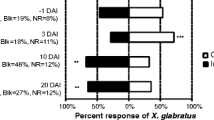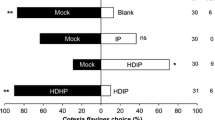Abstract
Insect-vectored plant pathogens are known to alter host-plant quality and associated cues, subsequently affecting the frequency of interactions with vectors and influencing pathogen transmission. It is unknown whether these changes deliver information highly specific to the vector and have evolved as a result of host manipulation or if they are more generalist indicator of plant status. In the current study, the responses of two thrips species, Frankliniella occidentalis Pergande, the vector of the tospovirus Tomato spotted wilt virus (TSWV) and a non-vectoring species, F. tritici Fitch, to pathogen-induced plant volatiles (PIPVs) in tomatoes were investigated. As the two species cohabit, and one is a vector of tospoviruses while the other is not, this system is perfectly suited to investigate the specificity of PIPVs to insect vectors. Both species were exposed to PIPVs of TSWV and the begomovirus Tomato yellow leaf curl virus (TYLCV) transmitted by the sweet potato whitefly, Bemisia tabaci Gennadius. Frankliniella tritici did not respond to PIPVs. F. occidentalis was attracted to both TSWV- and TYLCV-infected plants and showed no preference between plants infected by either virus. Volatiles from TSWV- and TYLCV-infected plants were collected and identified using GC–MS. Principal component analysis showed a clear differentiation between the volatiles of the uninfected and infected tomatoes. There was no differentiation between the volatile profiles of the two virus-infected tomatoes, suggesting that PIPVs may be a by-product of viral infection that elicit a generalist response in F. occidentalis and are likely not the result of host manipulation.



Similar content being viewed by others
Availability of data and materials
The datasets generated during and/or analyzed during the current study are available from the corresponding author on reasonable request.
References
Abe H, Tomitaka Y, Shimoda T et al (2012) Antagonistic plant defense system regulated by phytohormones assists interactions among vector insect, thrips and a tospovirus. Plant Cell Physiol 53:204–212. https://doi.org/10.1093/pcp/pcr173
Blanc S, Michalakis Y (2016) Manipulation of hosts and vectors by plant viruses and impact of the environment. Curr Opin Insect Sci 16:36–43. https://doi.org/10.1016/j.cois.2016.05.007
Carmo-Sousa M, Moreno A, Garzo E, Fereres A (2014) A non-persistently transmitted-virus induces a pull–push strategy in its aphid vector to optimize transmission and spread. Virus Res 186:38–46. https://doi.org/10.1016/j.virusres.2013.12.012
Castle SJ, Berger PH (1993) Rates of growth and increase of Myzus persicae on virus-infected potatoes according to type of virus-vector relationship. Entomol Exp Appl 69:51–60. https://doi.org/10.1111/j.1570-7458.1993.tb01727.x
Chen G, Su Q, Shi X et al (2017) Odor, not performance, dictates Bemisia tabaci’s selection between healthy and virus infected plants. Front Physiol. https://doi.org/10.3389/fphys.2017.00146
Eigenbrode SD, Bosque-Pérez NA, Davis TS (2018) Insect-borne plant pathogens and their vectors: ecology, evolution, and complex interactions. Annu Rev Entomol 63:169–191. https://doi.org/10.1146/annurev-ento-020117-043119
Fang Y, Jiao X, Xie W et al (2013) Tomato yellow leaf curl virus alters the host preferences of its vector Bemisia tabaci. Sci Rep 3:2876. https://doi.org/10.1038/srep02876
Funderburk J (2009) Management of the Western Flower thrips (Thysanoptera: Thripidae) in fruiting vegetables. Fla Entomol 92:1–6. https://doi.org/10.1653/024.092.0101
Ingwell LL, Eigenbrode SD, Bosque-Pérez NA (2012) Plant viruses alter insect behavior to enhance their spread. Sci Rep. https://doi.org/10.1038/srep00578
Jiménez-Martínez ES, Bosque-Pérez NA, Berger PH, Zemetra RS (2004) Life history of the bird cherry-oat aphid, Rhopalosiphum padi (Homoptera: Aphididae), on transgenic and untransformed wheat challenged with Barley yellow dwarf virus. J Econ Entomol 97:203–212. https://doi.org/10.1093/jee/97.2.203
Johnston N, Martini X (2020) The influence of visual and olfactory cues in host selection for Bemisia tabaci Biotype B in the presence or absence of Tomato yellow leaf curl virus. Insects 11(2). https://doi.org/10.3390/insects11020115
Kirk WDJ, de Kogel WJ, Koschier EH, Teulon DAJ (2021) Semiochemicals for thrips and their use in pest management. Annu Rev Entomol 66:101–119. https://doi.org/10.1146/annurev-ento-022020-081531
Li R, Weldegergis BT, Li J et al (2014) Virulence factors of geminivirus interact with MYC2 to subvert plant resistance and promote vector performance. Plant Cell 26:4991–5008. https://doi.org/10.1105/tpc.114.133181
Mann RS, Ali JG, Hermann SL et al (2012) Induced release of a plant-defense volatile ‘deceptively’ attracts insect vectors to plants infected with a bacterial pathogen. PLoS Pathog 8:e1002610. https://doi.org/10.1371/journal.ppat.1002610
Maris PC, Joosten NN, Goldbach RW, Peters D (2004) Tomato spotted wilt virus infection improves host suitability for its vector Frankliniella occidentalis. Phytopathology 94:706–711. https://doi.org/10.1094/PHYTO.2004.94.7.706
Martini X, Pelz-Stelinski KS, Stelinski LL (2014) Plant pathogen-induced volatiles attract parasitoids to increase parasitism of an insect vector. Front Ecol Evol. https://doi.org/10.3389/fevo.2014.00008
Martini X, Hoffmann M, Coy MR et al (2015) Infection of an insect vector with a bacterial plant pathogen increases its propensity for dispersal. PLoS ONE 10:e0129373. https://doi.org/10.1371/journal.pone.0129373
Martini X, Hughes MA, Killiny N et al (2017) The fungus Raffaelea lauricola modifies behavior of its symbiont and vector, the redbay ambrosia beetle (Xyleborus Glabratus), by altering host plant volatile production. J Chem Ecol 43:519–531. https://doi.org/10.1007/s10886-017-0843-y
Mauck KE (2016) Variation in virus effects on host plant phenotypes and insect vector behavior: What can it teach us about virus evolution? Curr Opin Virol 21:114–123. https://doi.org/10.1016/j.coviro.2016.09.002
Mauck KE, de Moraes CM, Mescher MC (2010) Deceptive chemical signals induced by a plant virus attract insect vectors to inferior hosts. Proc Natl Acad Sci 107:3600–3605. https://doi.org/10.1073/pnas.0907191107
Mauck K, Bosque-Pérez NA, Eigenbrode SD et al (2012) Transmission mechanisms shape pathogen effects on host-vector interactions: evidence from plant viruses. Funct Ecol 26:1162–1175. https://doi.org/10.1111/j.1365-2435.2012.02026.x
Mauck KE, de Moraes CM, Mescher MC (2016) Effects of pathogens on sensory-mediated interactions between plants and insect vectors. Curr Opin Plant Biol 32:53–61. https://doi.org/10.1016/j.pbi.2016.06.012
Mauck KE, Chesnais Q, Shapiro LR (2018) Evolutionary determinants of host and vector manipulation by plant viruses. Adv Virus Res 101:189–250. https://doi.org/10.1016/bs.aivir.2018.02.007
Mayer CJ, Vilcinskas A, Gross J (2008) Phytopathogen lures its insect vector by altering host plant odor. J Chem Ecol 34:1045–1049. https://doi.org/10.1007/s10886-008-9516-1
Mouden S, Sarmiento KF, Klinkhamer PG, Leiss KA (2017) Integrated pest management in western flower thrips: past, present and future. Pest Manag Sci 73:813–822. https://doi.org/10.1002/ps.4531
Mwando NL, Tamiru A, Nyasani JO et al (2018) Maize Chlorotic Mottle Virus induces changes in host plant volatiles that attract vector thrips species. J Chem Ecol 44:681–689. https://doi.org/10.1007/s10886-018-0973-x
Nachappa P, Margolies DC, Nechols JR et al (2013) Tomato Spotted Wilt Virus benefits a non-vector arthropod, Tetranychus urticae, by modulating different plant responses in tomato. PLoS ONE 8:e75909. https://doi.org/10.1371/journal.pone.0075909
Nachappa P, Challacombe J, Margolies DC et al (2020) Tomato Spotted Wilt Virus benefits its thrips vector by modulating metabolic and plant defense pathways in tomato. Front Plant Sci. https://doi.org/10.3389/fpls.2020.575564
Ng JCK, Falk BW (2006) Virus-vector interactions mediating nonpersistent and semipersistent transmission of plant viruses. Annu Rev Phytopathol 44:183–212. https://doi.org/10.1146/annurev.phyto.44.070505.143325
Nishida R, Shelly TE, Whittier TS, Kaneshiro KY (2000) α-Copaene, a potential rendezvous cue for the mediterranean fruit fly, Ceratitis Capitata? J Chem Ecol 26:87–100. https://doi.org/10.1023/A:1005489411397
Ogada PA, Maiss E, Poehling H-M (2013) Influence of tomato spotted wilt virus on performance and behaviour of western flower thrips (Frankliniella occidentalis). J Appl Entomol 137:488–498. https://doi.org/10.1111/jen.12023
Picard I, Hollingsworth RG, Salmieri S, Lacroix M (2012) Repellency of essential oils to Frankliniella occidentalis (Thysanoptera: Thripidae) as affected by type of oil and polymer release. J Econ Entomol 105:1238–1247. https://doi.org/10.1603/EC11292
Reitz SR, Gao Y, Kirk WDJ et al (2020) Invasion biology, ecology, and management of western flower thrips. Annu Rev Entomol 65:17–37. https://doi.org/10.1146/annurev-ento-011019-024947
Ren X, Wu S, Xing Z et al (2020a) Behavioral responses of western flower thrips (Frankliniella occidentalis) to visual and olfactory cues at short distances. InSects 11:177. https://doi.org/10.3390/insects11030177
Ren X, Wu S, Xing Z et al (2020b) Abundances of thrips on plants in vegetative and flowering stages are related to plant volatiles. J Appl Entomol 144:732–742. https://doi.org/10.1111/jen.12794
Shalileh S, Ogada PA, Moualeu DP, Poehling HM (2016) Manipulation of Frankliniella occidentalis (Thysanoptera: Thripidae) by Tomato Spotted Wilt Virus (Tospovirus) via the host plant nutrients to enhance its transmission and spread. Environ Entomol. https://doi.org/10.1093/ee/nvw102
Shi X, Chen G, Tian L et al (2016) The salicylic acid-mediated release of plant volatiles affects the host choice of Bemisia tabaci. Int J Mol Sci 17:1048. https://doi.org/10.3390/ijms17071048
Shrestha A, Srinivasan R, Riley DG, Culbreath AK (2012) Direct and indirect effects of a thrips-transmitted tospovirus on the preference and fitness of its vector, Frankliniella fusca. Entomol Exp Appl 145:260–271. https://doi.org/10.1111/eea.12011
Stafford CA, Walker GP, Ullman DE (2011) Infection with a plant virus modifies vector feeding behavior. Proc Natl Acad Sci 108:9350–9355. https://doi.org/10.1073/pnas.1100773108
Tomitaka Y, Abe H, Sakurai T, Tsuda S (2015) Preference of the vector thrips Frankliniella occidentalis for plants infected with thrips-non-transmissible Tomato spotted wilt virus. J Appl Entomol 139:250–259. https://doi.org/10.1111/jen.12165
Wu S, Xing Z, Ma T et al (2021) Competitive interaction between Frankliniella occidentalis and locally present thrips species: a global review. J Pest Sci 94:5–16. https://doi.org/10.1007/s10340-020-01212-y
Wu X, Xu S, Zhao P et al (2019) The Orthotospovirus nonstructural protein NSs suppresses plant MYC-regulated jasmonate signaling leading to enhanced vector attraction and performance. PLoS Pathog 15:e1007897. https://doi.org/10.1371/journal.ppat.1007897
Acknowledgements
We would like to thank Dr. Scott Adkins at the United States Department of Agriculture Agricultural Research Service in St. Lucie County for providing populations of F. occidentalis to help establish insect colonies for the olfactometer assays. We would also like to thank Brianna Carter, Maclane Suber, and Sebastian Bayard for assistance in completing olfactometer assays. This research was financially supported by the Southern Sustainable Agriculture Research and Education graduate student grant (GS18-191).
Funding
This research was financially supported by the Southern Sustainable Agriculture Research and Education graduate student grant (GS18-191).
Author information
Authors and Affiliations
Corresponding author
Ethics declarations
Conflict of interest
The authors have no relevant financial or non-financial interests to disclose.
Ethical approval
This article does not contain any studies with human participants and/or animals other than insects performed by any of the authors.
Additional information
Communicated by Paul Becher.
Publisher's Note
Springer Nature remains neutral with regard to jurisdictional claims in published maps and institutional affiliations.
Supplementary Information
Below is the link to the electronic supplementary material.
Rights and permissions
Springer Nature or its licensor (e.g. a society or other partner) holds exclusive rights to this article under a publishing agreement with the author(s) or other rightsholder(s); author self-archiving of the accepted manuscript version of this article is solely governed by the terms of such publishing agreement and applicable law.
About this article
Cite this article
Strzyzewski, I., Funderburk, J. & Martini, X. Specificity of vectoring and non-vectoring flower thrips species to pathogen-induced plant volatiles. J Pest Sci 96, 441–449 (2023). https://doi.org/10.1007/s10340-022-01588-z
Received:
Revised:
Accepted:
Published:
Issue Date:
DOI: https://doi.org/10.1007/s10340-022-01588-z




